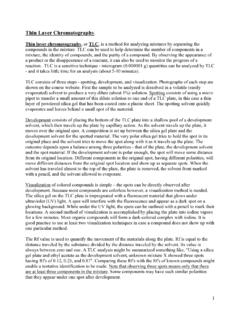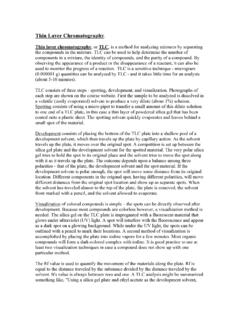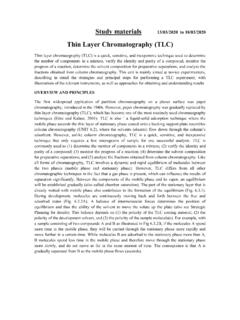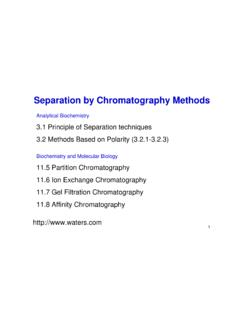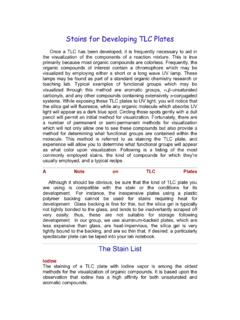Transcription of Teaching notes: Chromatography - AQA
1 Teaching notes: Chromatography These Teaching notes relate to section of our A-level Chemistry specification. This resource aims to provide background material for teachers preparing students for A-level Chemistry. It is provided as an additional resource to cover specification topics which teachers may not be familiar with. This information goes beyond the requirements of the specification. It may well be of interest to students but the specification indicates the limits of the knowledge and understanding of this topic that will be examined. Specification overview Chromatography provides an important method of separating and identifying components in a mixture. Different types of Chromatography are used depending on the composition of mixture to be separated.
2 Content Opportunities for skills development Chromatography can be used to AT a, i and k separate and identify the components PS , and in a mixture. Students could use thin -layer Types of Chromatography include: Chromatography to identify analgesics. thin -layer Chromatography Students could use thin -layer (TLC) a plate is coated with a Chromatography to identify transition solid and a solvent moves up metal ions in a solution. the plate column Chromatography (CC) . a column is packed with a solid and a solvent moves down the column gas Chromatography (GC) a column is packed with a solid or with a solid coated by a liquid, and a gas is passed through the column under pressure at high temperature. Separation depends on the balance between solubility in the moving phase and retention by the stationary phase.
3 Retention times and Rf values are used to identify different substances. The use of mass spectrometry to analyse the components separated by GC. Students should be able to: calculate Rf values from a chromatogram compare retention times and Rf values with standards to identify different substances. Required practical 12. Separation of species by thin -layer Chromatography . Chromatography types Chromatography is a practical technique used to separate and identify the components in a mixture. Chromatography involves a mixture being dissolved in a mobile phase (which could be a liquid or a gas), that is then passed through an immobile stationary phase (which is usually a solid). The phases are chosen so that components in the mixture have differing interactions in each phase; the balance of these two factors determines the rate of movement of a component which is recorded as either an Rf value or a retention time and used in a component's identification.
4 Examples of types of Chromatography include: thin -layer Chromatography column Chromatography gas Chromatography . thin -layer Chromatography (TLC). Figures and show the apparatus required to analyse a mixture (m). believed to contain some components (a, b and c). Figure : apparatus at the start of the experiment. A plate made from glass or aluminium or an inert plastic is coated with a powdered solid such as silica or alumina. The mixture (m) and pure samples of each component (a, b and c) are spotted on a pencil line drawn near one end of the plate (Figure ). A range of solvents with different polarities can be used. A. solvent is chosen to carry the components up the plate at different rates. A. sealed system is used, such as the beaker and lid in Figure , to increase the speed of the procedure and to reduce loss of solvent.
5 The distance each component moves is measured and compared to the solvent front, enabling an Rf value to be calculated. If any component is insoluble in the solvent, it will remain on the pencil line; if this happens then the experiment is repeated with a different solvent. Figure : the TLC plate after the experiment. The Rf values of the components a, b and c are , and respectively. The chromatogram shows that mixture m contains at least three components which could be a, b and an unknown; it is possible that the spots of any of these three components actually represent two materials with the same Rf in the solvent selected! In TLC, the solubility of a substance in the solvent is important; the substance will rise further up the plate (and have a greater Rf value) if a more effective solvent is used.
6 Resources Stains or sprays such as iodine vapour or ninhydrin (used to identify compounds on TLC plates). Some plates have a fluorescent indicator;. under light the plate will glow green all over, except where the fluorescent indicator has been blocked by the presence of any substance. TLC plates. They are relatively expensive to purchase, typically 25. aluminium or plastic sheets (20 cm 20 cm) can be purchased for approximately 140. 50 smaller size plates (8 cm 4 cm) cost approximately 70. All these plates can be cut into smaller sizes. Column Chromatography (CC). A glass tube is filled with the stationary phase usually silica or alumina in powder form to increase the surface area or an ion exchange resin in the form of small granules; a filter or plug is used to retain the solid in the tube.
7 Solvent is then added to cover all the powder. Figure : the mixture to be analysed is dissolved in a minimum of a solvent and added to the column. A solvent or mixture of solvents is then run through the column. The time for each component to reach the end of the column is recorded; this is known as the retention time (Figure ). Figure : the solvent is run through the column. As in TLC, the solubility of a substance in the solvent is important as this determines how fast each component moves through the column. The substance will move faster down the column if a more effective solvent is used. This demonstration shows steps to separate a mixture of compounds using ion exchange column Chromatography : ion exchange resin is poured into a column dilute sulfuric acid is run through the column until the resin is just covered a green mixture of 10 cm3 of (blue) copper sulfate solution and 2 cm3 of (yellow) potassium chromate solution is poured onto the column water is run through the column; the blue colour is retained by the column and the eluent will turn yellow if dilute sulfuric acid is then used as the mobile phase the blue solution can be collected, the resin is recharged and can be re-used.
8 The following website offers further information on packing Chromatography columns. Gas Chromatography (GC). The column is a capillary glass or metal tube filled with a solid or a liquid adsorbed onto a solid, which acts as the stationary phase. Such columns can have an inner diameter of less than 1 mm and be up to 60 m long. Figure : the size of a column relative to a credit card. Figure : an oven where the column is placed. An inert carrier gas such as helium, argon or nitrogen is the mobile phase used to separate the volatile components of a mixture. This technique is usually carried out under pressure at high temperature. At the end of the column a range of detectors can be used to identify each component and the retention time for each component can be recorded.
9 Gas Chromatography mass spectrometry (GCMS). One sophisticated type of GC is Gas Chromatography mass spectrometry (GCMS). where the separated components are ionised as they emerge from the column and both the identity and quantity are determined by mass spectrometry. Figure : a picture of a GCMS. Practical uses of Chromatography Nitrating 3-bromobenzene: TLC using silica plates with water as solvent to compare 3-bromobenzene, impure and purified products. Preparation of paracetamol from 4-aminophenol: TLC using silica plates with 2:1 solvent mixture of ethyl ethanoate to cyclohexane to compare 4-aminophenol, mixture of 4-aminophenol and paracetamol, recrystallised sample of paracetamol and pure paracetamol. Transition metals see required practical.
10 Philae lander on Rosetta probe see TOF mass spectrometry teachers'. notes. Acknowledgement With thanks to the School of Earth, Atmospheric and Environmental Sciences at the University of Manchester for permission to take photographs and informal discussions. Copyright 2015 AQA and its licensors. All rights reserved.










